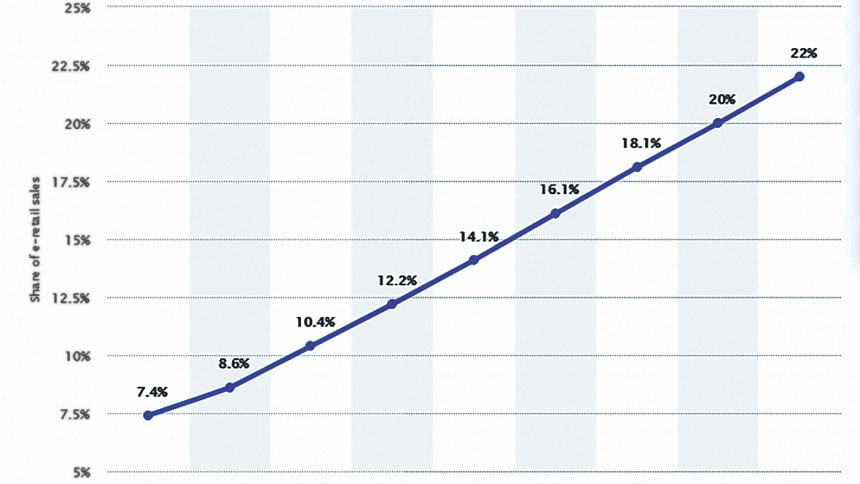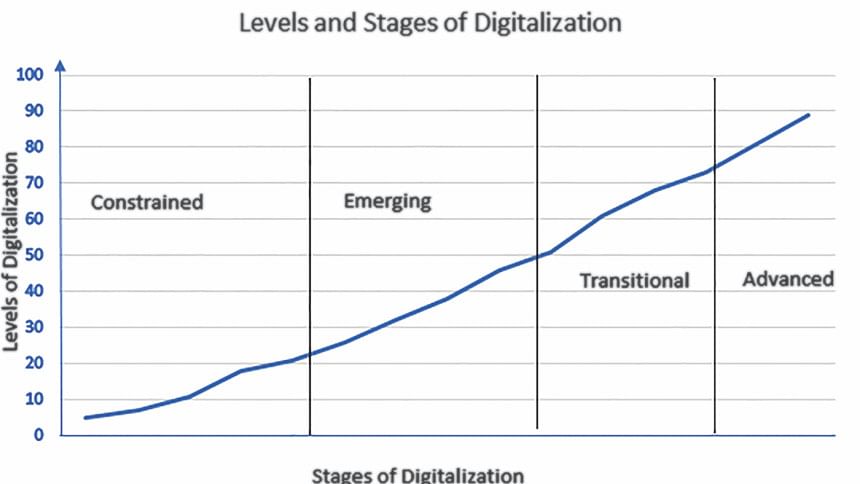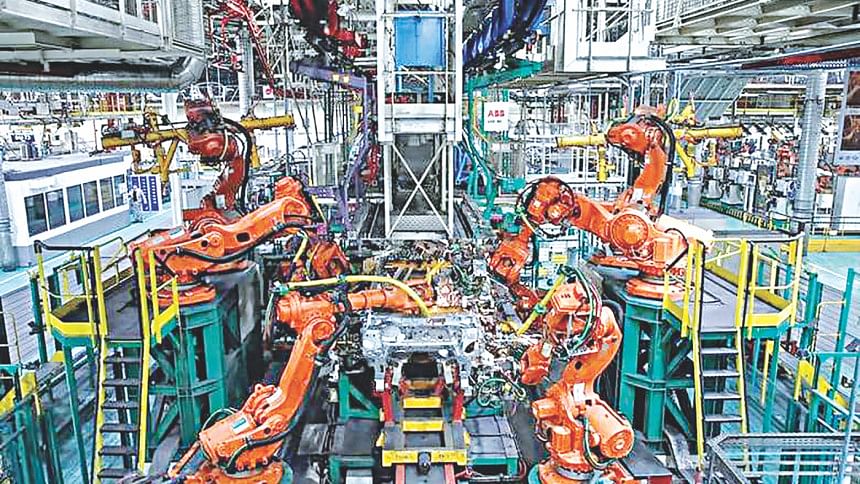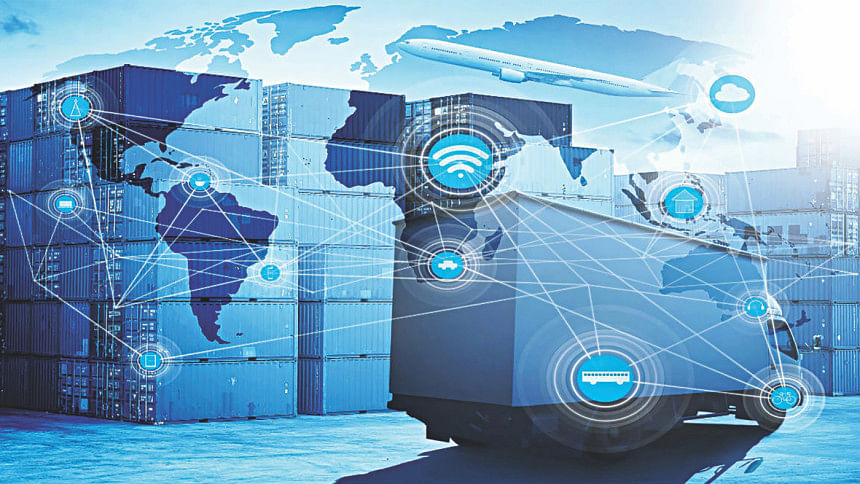How digitisation is changing the global economic landscape

There can be no doubt that the process of digitalisation is affecting almost all aspects of the world economy. This all-encompassing transformation, mostly in the realm of activities around digital communication and digital media, has brought about a wide-range of changes in our economic and social universe. "Mobile and cloud computing, the Internet of things, artificial intelligence, and big data are not only transforming business activities but also generating new business models which require new firm strategies and affect innovation, consumer behaviour and society in general."
So, what is digitalisation? According to Lexico, the online version of the Oxford Dictionary, "Digitalisation is the conversion of text, pictures, or sound into a digital form that can be processed by a computer." Wikipedia, the modern or online version of Encyclopedia Britannica, uses the terms digitisation and digitalisation synonymously, and alludes to "the representation of an object, image, sound, document or signal (usually an analogue signal) by generating a series of numbers that describe a discrete set of its points or samples…strictly speaking, digitising simply means the conversion of analogue source material into a numerical format." Since this definition appears to focus on the physical process of conversion, it leaves out many other important changes that are happening in the modern world. For example, we are today stepping into a world where autonomous vehicles (or driverless cars) might soon revolutionise transportation. Neither of these definitions of digitalisation takes into account/encompass these changes or the newly popularised fields of drones and e-commerce.
Gartner, one of the world's leading research and market research firm in technology, defines digitalisation as, "the use of digital technologies to change a business model and provide new revenue and value-producing opportunities; it is the process of moving to a digital business." Dr Uwe Riss, Senior Researcher at SAP, the German company and a global tech giant in the field of systems, applications and products in data processing, however, makes a distinction between digitisation and digitalisation. "Now we are on the way to digitalisation, which is different. Digitising has increased the efficiency of our processes; digitalisation means that business now uses technology to engage with people to precisely address their particular needs."
Since my focus in this article is the impact of digitalisation on the global economy, I will use the terms digitalisation and digitisation interchangeably and in the broadest sense. However, the impact of the digital revolution is everywhere, and to do justice to the topic at hand, we will limit our discussion to three economic issues: trade/commerce, employment and industrial production.
Labour and industry
According to an econometric analysis performed by an international consulting group Booz & Company,w an increase in digital activities by 10 percent can reduce a country's unemployment rate by .84 percent. "From 2009 to 2010, digitisation added an estimated 19 million jobs to the global economy, up 5 percent from the estimated 18 million jobs added from 2007 to 2008."
According to several studies conducted by the Organization for Economic Cooperation and Development (OECD), the adoption of digital technologies is generally associated with substantially higher firm-level productivity. "These results hold for a range of different technologies (high-speed broadband access, simple and complex cloud computing, CRM and ERP software). This association is stronger in manufacturing industries and more generally in industries that are intensive in routine tasks, suggesting that digital adoption can streamline production processes and to some extent act as a substitute for routine labour input."
The digital transformation of one's own economy thus becomes a prerequisite for securing and improving a country's prosperity. In a recently published paper, "Digital Economy: How is digitalization changing global competitiveness and economic prosperity?" Dr T Petersen, Senior Advisor, Bertelsmann Stiftung, strongly advocates that developing countries such as Bangladesh improve its international competitiveness by building a digital infrastructure and promoting the education sector.
Digitisation will upend the traditional theory of "comparative advantage" according to which South Asian countries have an edge in cheap labour-intensive goods. However, in the new age, digital technologies empower
countries which have a literate and tech-savvy population. Consequently, new areas of comparative advantage are emerging, particularly in software development, technical support, and call centres, leading to cross-border relocation of production sites. Production processes will increasingly become digital-technology intensive. "When human labour is increasingly used by robots, computers and machines, the labour-intensive developing countries lose their decisive competitive advantage: cheap labour. In future, the international competitiveness of individual economies will depend crucially on how quickly digital technologies are used in production processes. This digital transformation, in turn, depends on whether a country has the necessary resources for this transformation."

A word of caution. As automation, robotics, and AI technologies are advancing rapidly, concerns that new technologies will render labour redundant have subsequently intensified. In a scientific paper co-authored by MIT's economist Daron Acemoglu, one can see that new technologies, particularly automation, may reduce employment by reducing the demand for products and tasks which are unskilled and labour-intensive. In their paper entitled "The Race between Man and Machine: Implications of Technology for Growth, Factor Shares, and Employment", however, Acemoglu and Pascual Restrepo also report that capital investment in new technology can reverse the labour displacement trend, and create new tasks which are labour-intensive.
International trade
The impact of digitalisation on international trade has been quite visible in the last two decades. First of all, digital means goods and services can be shipped across the border, and continents, cheaply and quickly. The role of the service sector is crucial in this regard. WTO has warned its member countries that the rapid development of digital technologies in recent times has the potential to transform international trade profoundly in the years to come. One conclusion that stands out is that the expansion of digital technologies will reduce the transaction costs of international trade. Between 1996 and 2014, international trade costs declined by 15 percent. WTO predicts that technological change will reduce costs further and as a result, trade could grow yearly by 1.8 to 2 percentage points more until 2030. This would result in a cumulative growth in international trade of 31 to 34 percentage points over 15 years.
Digitisation has also changed the composition of trade by increasing the services component, "fostering trade in certain goods such as time-sensitive products, changing patterns of comparative advantage and affecting the complexity and length of global value chains." For countries in South Asia, growth in the ICT sector will enable it to fully participate in the surge in services trade. New services will emerge which will be outsourced to our ICT firms, and will further boost employment in the technology sector and promote exports. It is expected that the share of service trade could grow from 21 percent to 25 percent by 2030.
Digitisation has led to the flourishing of e-commerce with the domination of Amazon, JD.com and Alibaba. E-commerce is booming thanks to the widespread use of the internet and of internet-enabled devices which provide consumers with direct access to online markets.
As the first chart shows, the share of e-commerce in retail sales doubled between 2015 and 2020. Small and medium firms—and not only Amazon and Alibaba—are also "surfing this wave, as digital technologies allow for easier entry into markets and increased product diversity, making it easier for them to produce, promote and distribute their products at a lower cost."

At the country level, the impact of digitalisation can be seen in productivity gains, broader participation of SME, and easier access to the global market. One can gauge the domination of digital technology in trade and consumers' taste by making a quick stop at the Consumer Electronics Show (CES) held in Las Vegas, Nevada, each year. CES offers companies across the globe an opportunity to display new products and technologies, not only in the consumer electronics industry but also across the broad spectrum of digitisation.
According to a tech magazine reporter, "automotive has become a major part of CES with focus on innovation in electric vehicles, infotainment, telematics, autonomous capabilities and ride sharing. Even major OEMs are now using CES to introduce new automotive technologies to the public the first time. Suppliers to the automotive industry involving electronics are increasingly present at the CES. At the CES 2020, it was particularly noticeable that a large number of vendors in autonomous (self-driving) technology were present." This includes Mercedes, Sony, and dozens of other start-ups. Incidentally, a spin-off, CES Asia, will take place next June in Shanghai and it is already an annual event.
How to measure a country's level of digitalisation
Digitalisation is a complex phenomenon that is hardly captured by a single indicator. As a matter of fact, digital technologies affect different dimensions of economic activities, including capital, labour and markets. Measuring the spread of digital technology is made harder with the successful inroads made by some new digital technologies—labelled "disruptive" technologies—and manifesting in the Internet of Things, artificial intelligence, 3D printing and Blockchain.
Booz & Company has grouped the world into four clusters of digitisation: Constrained, Emerging, Transitional and Advanced. To compare the level of technology adoption of countries, we need to focus on adoption statistics. In this respect, we measure the use of "cloud computing, social media, e-invoicing, electronic information sharing (e.g. ERP), Radio Frequency Identification (RFID), and eventually the percentage of small and medium-sized firms (SMEs) selling online, their percentage of turnover made from e-commerce and their percentage of cross-border online sales".

As we can see—and if we scan around also foresee—digitalisation is spreading its tentacles into all areas of modern society, particularly the global economic landscape. There is hardly any corner of manufacturing, trade or finance that has not been changed to some extent by the use of digital technology, computers, robots, or AI.
Another consideration is that different sectors of activity are affected by digital technologies in heterogeneous ways. This heterogeneity across sectors will likely depend on the dimension of digitalisation considered. For instance, a sector where a high number of digital transactions occur might not necessarily be characterised by a very high presence of ICT specialists, and vice versa.
Regardless of the level of adoption, the first and foremost impact on an economy has been the growth of telecom and big data and its continuous encroachment in fields as far spread out as medicine, education, and transportation. In medicine, digitalisation has led to faster and more accurate diagnosis, better treatment, and development of effective cure. Detailed data has the potential to improve health outcomes. Large troves of data help fuel algorithms to detect lung cancer, eye disease, and kidney injuries. Electronic health record systems (EHR) also reduce error rates and cut down on paperwork.
Looking into the future, soon we will see our country fast embracing digital technology in healthcare, transportation, and logistics, and professional and business services. Technology is also making inroads into construction, retail, and manufacturing, albeit slowly. We need to keep our eyes on the global market for electric vehicle and charging docks. Customer service and call centres are locating to countries that have a lower cost of living. Instant and low-cost digital communication has lowered transaction cost. Microprocessors, storage, and bandwidth are getting cheaper.
The role of AI and machine learning
Artificial Intelligence (AI) is one of the major innovations of the twenty-first century. Despite its short life—its commercial birth happened in 2012—it has rapidly become a significant influence on our economic and social activities, particularly in the USA and China, which are investing heavily in this field.
In a seminal paper on the economic effect of artificial intelligence (AI), two economists at the National Bureau of Economic Research, a prestigious think-tank in Cambridge, Massachusetts,
have conducted an in-depth and analytical study of the ramifications of AI on international trade. "AI will likely raise average incomes and improve well-being but it may also disrupt labour markets, raise inequality and drive non-inclusive growth."
The study by Professors Goldfarb and Trefler of Rotman School of Management, University of Toronto, shows that seven of the world's 12 largest companies are each heavily engaged in AI. At the top are Apple, Alphabet/Google, Amazon and Microsoft, but two Chinese privately-owned companies—Tencent and Alibaba—have now joined this elite club with the highest AI exposure.
In the next decade, we shall see more technologies built on AI or machine learning. Its application in the areas of facial recognition and voice recognition shows us the potential of machine learning. Chips that are customised for machine learning are increasing speed and cutting costs. Stanford University's 2019 AI Index report maps out how processor speeds double every 18 months to two years, which means application developers can expect a doubling in application performance for the same hardware cost. The report has found that post-2012, the speed of artificial intelligence (AI) has outpaced Moore's Law, i.e., AI computational power is accelerating faster than traditional processor development. AI will use data that are collected and find patterns to enhance productivity, in factories, manufacturing and irrigation.

Some policy implications
A recent WTO report titled, "2018 World Trade Report: How Digital Technologies are Transforming Global Commerce", concludes that the expansion of digital trade is likely to entail considerable benefits but international cooperation is needed to help governments ensure that digital trade continues to be an engine of inclusive economic development. The report finds that the decline in trade costs can be especially beneficial for micro, small and medium-sized enterprises, and for firms from developing countries, if appropriate complementary policies are put in place and challenges related to technology diffusion and regulation are addressed. Estimates conducted by WTO foresee that, in such a scenario, developing countries' share in global trade could grow from 46 percent in 2015 to 57 percent by 2030.
Notwithstanding the benefits of digital technologies, they are also giving rise to a number of concerns. This includes market concentration, loss of privacy, security threats, the digital divide, and the question of whether digital technologies have really increased productivity. Access to data is a prerequisite for the development and adoption of digital tools.
In their study, Goldfarb and Trefler highlight five policy areas that need attention. The first three involve data: domestic privacy policy, data localisation rules and access to government data. The others are the development of regulations for AI application industries (such as autonomous vehicles) and protection of source code. Privacy policy, data localisation and source code access have already become significant trade issues, for example, in US-China trade agreement (Phase I) and USMCA (former NAFTA).
More research is needed on the international trade and cross-country implications of AI, big data, and the global digital footprint. "Yet, even to the extent that progress has been made in understanding the impact of AI, we remain largely uninformed about its international dimensions. The international dimensions of AI innovations and policies have not always been well thought out," argue Goldfarb and Trefler of the University of Toronto.
Dr Abdullah Shibli is an economist and works in information technology. He is Senior Research Fellow, International Sustainable Development Institute (ISDI), a think-tank in Boston, USA.

 For all latest news, follow The Daily Star's Google News channel.
For all latest news, follow The Daily Star's Google News channel. 



Comments